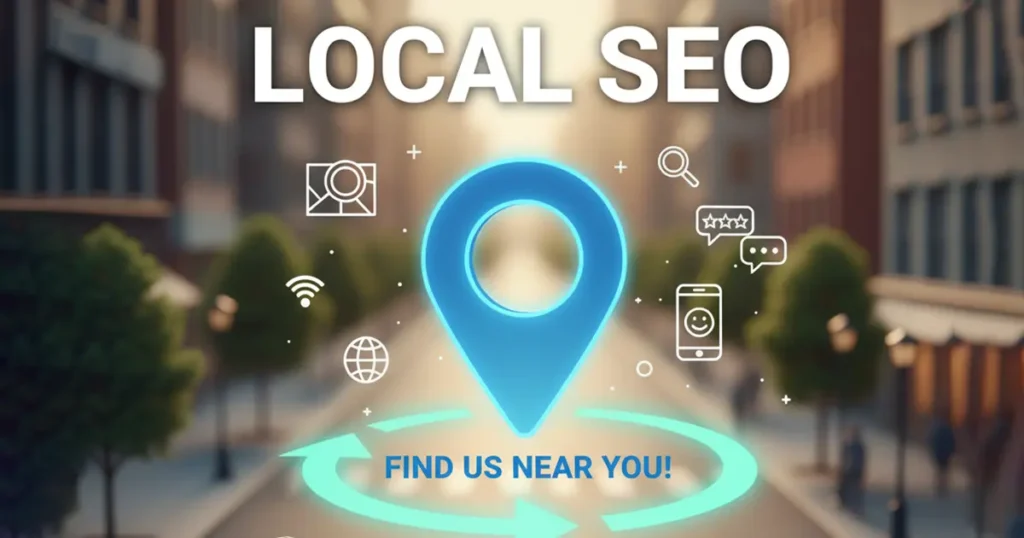In today’s digital-first world, being found online by nearby customers is essential for every small or local business. That’s where Local SEO comes in. If you’ve ever searched for “restaurants near me” or “best salon near me,” you’ve already seen local SEO in action. But what is local SEO, and how does it actually work to grow your business?
Local SEO (Local Search Engine Optimization) is a targeted marketing strategy that helps businesses improve visibility in Google’s local search results, Maps listings, and local packs. Whether you run a café, law firm, or repair shop, optimizing your online presence ensures nearby customers can easily find and trust your business. Professional local SEO services enhance your visibility through Google Business Profile optimization, citation building, and review management, helping you attract more local leads and strengthen your brand presence in the community.
What Is Local SEO?
Local SEO refers to the process of optimizing your online presence to attract more local customers through search engines like Google. It focuses on improving visibility for location-based searches such as “dentist in Houston” or “plumber near me.”
The main goal of local search optimization is to help small and medium-sized businesses appear in local search results and Google Maps when users look for nearby services. In simple terms, Local SEO connects your business to people searching for your products or services within your geographical area.
Local SEO vs. Traditional SEO
While traditional SEO focuses on improving a website’s visibility on a national or global level, Local SEO is designed to capture attention from potential customers within a specific geographic area. It helps businesses appear in Google Maps, local packs, and location-based searches by optimizing their Google Business Profile, maintaining consistent local citations, and targeting geo-specific keywords. In essence, traditional SEO builds a broad digital presence, while Local SEO strengthens a business’s visibility in its immediate community.
Here’s how they differ:
- Target Audience: Local SEO connects businesses with nearby customers searching for local services, while traditional SEO targets users regardless of location.
- Ranking Factors: Local SEO relies on signals like proximity, relevance, reviews, and NAP consistency, whereas traditional SEO prioritizes backlinks, domain authority, and content optimization.
- Search Intent: Local SEO focuses on “near me” or location-based searches with high purchase intent, while traditional SEO addresses informational or broad intent queries.
Why Local SEO Is Important
Local SEO is important because it helps your business appear in front of potential customers exactly when they’re searching for your products or services nearby. It bridges the gap between online searches and in-person visits, driving more foot traffic, phone calls, and local leads.
With Google serving billions of local searches every month, showing up prominently for relevant queries significantly boosts your chances of attracting new customers. For small and local businesses, it’s one of the most effective ways to enhance visibility, credibility, and revenue, helping your brand stand out in competitive local markets.
Key Benefits of Local SEO:
- Higher local visibility: Appear in Google’s “local pack” and Maps results.
- Increased walk-ins: Convert searchers into store visitors.
- Improved ROI: Local SEO delivers better conversion rates than paid ads.
- Enhanced brand credibility: Positive reviews and consistent listings boost trust.
Did you know?
According to Google, 76% of users who perform a local search on their smartphone visit a nearby business within 24 hours, and 28% of those searches lead to an actual purchase.
How Local SEO Works
Understanding how Local SEO works is essential for improving your visibility in local searches and attracting nearby customers. Google uses a combination of factors to determine which businesses appear in Maps listings and local packs. By optimizing your Google Business Profile, maintaining accurate listings, and earning positive reviews, you can enhance your business’s authority and trustworthiness. In short, Local SEO helps search engines connect your business to users who are most likely to visit or contact you.
If your business also serves nearby towns, suburbs, or multiple service areas, implementing effective strategies for local SEO beyond your core location can help you extend your visibility and capture customers outside your immediate radius.
Key Local SEO Ranking Factors
Google uses several local SEO ranking factors, including:
- Relevance: How well your business matches a user’s query.
- Distance: How close your business is to the searcher’s location.
- Prominence: How well-known your business is online.
Other signals like online reviews, local backlinks, and NAP consistency (Name, Address, Phone number) also influence your rankings.
How Google’s Local Algorithm Works
To understand how Google’s local algorithm works, it’s important to know that Google aims to deliver the most relevant and trusted local results to users. The algorithm considers multiple signals to determine which businesses deserve top positions in local packs and Google Maps searches. These signals help Google assess how accurate, active, and popular your business is within your local area.
- Google Business Profile (GBP) optimization
- Citations and directory listings
- User behavior signals like clicks, calls, and reviews
By enhancing these factors, you can boost your Google Maps ranking and improve visibility in the local pack.
Best Local SEO Tools
Choosing the best Local SEO tools is essential for managing, tracking, and improving your local search performance effectively. These tools help you monitor rankings, manage citations, analyze competitors, and optimize your Google Business Profile with ease.
Free Local SEO Tools
- Google Business Profile: Manage your local listing and respond to reviews.
- Google Search Console: Monitor website SEO performance.
- Google Maps: Analyze visibility in nearby searches.
- Moz Local: Audit NAP citations and business listings.
Paid Local SEO Tools
- BrightLocal: Local rank tracking and citation management.
- Semrush Local & Listing Management: Generate local SEO reports and measure rankings by ZIP code.
- Whitespark: Build and manage citations effectively.
- Ahrefs & Yext: Analyze backlinks and maintain citation consistency.
How to Do Local SEO
Local SEO is all about creating a structured approach that improves your visibility in local searches and attracts nearby customers. It involves optimizing your website, Google Business Profile, and online citations while using location-based keywords to target the right audience. A well-rounded local SEO strategy not only enhances your search rankings but also builds trust, drives foot traffic, and helps your business stand out in competitive local markets.
To ensure you’re covering every crucial step, follow a detailed local SEO checklist that helps you stay organized and ensures you don’t overlook any elements that could affect your local rankings and overall visibility.
Here’s how you can do Local SEO effectively with these proven strategies to maximize your local reach and performance.
Do Local Keyword Research
Effective local SEO begins with solid keyword research that focuses on location-based search terms. These keywords help connect your business with people actively searching for products or services in your area. By identifying the right phrases, you can attract high-intent local traffic that’s ready to visit, call, or make a purchase.
Examples of Local Keywords
- “Best coffee shop in New York City”
- “Plumber near me in Los Angeles”
- “Affordable dentist in Chicago”
- “Roofing company in Dallas”
Using city-specific keywords like these helps Google associate your business with a particular location, increasing your chances of appearing in Google Maps and local pack results when nearby customers search for your services.
Analyze Competitors’ Keywords
Studying your competitors’ keyword strategies helps uncover opportunities your business might be missing. A detailed keyword gap analysis using tools like Semrush or Ahrefs can reveal search terms that drive traffic to similar local businesses. This insight allows you to refine your keyword targeting and strengthen your local search optimization efforts.
Use Google Autocomplete
Google’s autocomplete and People Also Ask sections provide valuable insight into real user queries. These features highlight the most common phrases people use when searching for local services. By integrating these naturally into your content, you can capture long-tail, conversational searches that often lead to higher conversions.

Leverage Local Keyword Research Tools
Using specialized local keyword research tools helps you stay on top of what your local audience is searching for. Platforms like Google Keyword Planner and Position Tracking tools can help identify trending search terms, track rankings by ZIP code, and measure performance over time. This data-driven approach ensures your content stays aligned with local search intent.
Optimize On-Page SEO for Local Visibility
Your website plays a central role in improving local search visibility. On-page optimization ensures search engines understand your business location, services, and relevance. Incorporate your city and service keywords in title tags, meta descriptions, and headers, and implement schema markup to enhance search visibility.
To strengthen local relevance:
- Create unique location pages for each service area.
- Ensure your website is mobile-friendly and loads quickly.
- Keep navigation intuitive to improve user experience.
Optimize Your Google Business Profile
Your Google Business Profile (GBP) is one of the most powerful assets for local SEO optimization. A complete and accurate profile ensures customers can easily find essential information like hours, address, and contact details. Verifying your business, selecting the right categories, and uploading high-quality photos help build trust and improve visibility in Google Maps and local pack results.
To make the most of your profile:
Add and verify your Business Profile to establish ownership and ensure accuracy.
Complete all essential details, including:
- Contact information (phone number, website, and address)
- Opening hours and holiday schedules
- High-quality photos and short videos showcasing your business
- Business attributes such as Wi-Fi availability, parking options, or outdoor seating
A fully optimized profile not only enhances your local search visibility but also encourages potential customers to engage with and trust your business.

Keep Your Profile Active
Regular activity on your Google Business Profile signals to Google that your business is active and engaged. Posting updates about offers, events, or new services helps maintain relevance and customer interest. Responding promptly to questions and reviews builds trust, while consistent engagement boosts your local ranking potential.
Build Consistent NAP Citations
Consistency across your Name, Address, and Phone number (NAP) is critical for effective local SEO optimization. When your business information is uniform across directories, websites, and social media platforms, Google can verify your credibility more easily. Inconsistent data, on the other hand, can confuse search engines and lower your local rankings.

Manage and Respond to Customer Reviews
Customer reviews are a major trust signal and one of the key local SEO ranking factors. Positive reviews enhance your online reputation, while timely responses, especially to negative feedback, show professionalism. Encouraging customers to leave Google reviews and using AI-assisted tools for quick replies can improve your brand image and influence local search performance.
Quick Tips for Managing Reviews:
- Encourage satisfied customers to leave honest feedback on Google.
- Respond to every review, thank positive reviewers, and address negative ones calmly.
- Use review management tools to automate alerts and track sentiment.
- Showcase top reviews on your website or social media for added credibility.
- Avoid fake or incentivized reviews; authenticity builds lasting trust.
Build Local Backlinks
High-quality local backlinks act as endorsements that signal your authority within the community. Partnering with nearby organizations, local blogs, and industry associations helps strengthen your credibility. You can also list your business in reputable local directories to improve relevance, authority, and visibility in local search results.
Effective Local Link-Building Strategies:
- Collaborate with local bloggers or influencers for mentions or reviews.
- Sponsor community events, charities, or local sports teams.
- Join local chambers of commerce or business associations.
- Submit your business to trusted local directories (e.g., Yelp, Angi, BBB).
- Partner with complementary local businesses for cross-promotional content or backlinks.
Monitor Your Progress and Rankings
Monitoring your Local SEO performance is essential to understand what’s working and where improvements are needed. Regular tracking helps you measure visibility in Google Maps, local packs, and organic search results. By analyzing data from SEO tools and analytics platforms, you can refine your strategies, identify growth opportunities, and maintain consistent progress in your local search rankings.
Track Google Maps Rankings
Monitoring your position on Google Maps is crucial for understanding your local visibility and reach. Tools like BrightLocal or Whitespark allow you to track your rankings across different locations and devices. Regularly checking your map rankings helps you identify trends, measure improvements, and stay ahead of local competitors.
Track SERP Performance in Local Pack
The local pack is often the first thing users see when searching for nearby services, making it vital to monitor your presence there. Using tools like Semrush Position Tracking or Ahrefs, you can track keyword rankings and assess how your business performs compared to others in your area. Consistent monitoring ensures your listing remains visible and competitive in high-traffic local searches.
Use Google Analytics
Measuring ROI from your Local SEO efforts helps determine which strategies deliver the best results. Platforms like Google Analytics and Google Business Insights provide valuable data on user interactions, including calls, direction requests, and website visits. Analyzing these metrics enables you to refine your campaigns, enhance engagement, and boost your overall local search visibility.
Start Growing Your Local Visibility Today
Local SEO isn’t just another marketing tactic; it’s a long-term growth engine for local and community-focused businesses. By optimizing your Google Business Profile, maintaining consistent citations, and actively engaging with your local audience, you can boost your rankings, increase visibility, and attract more walk-in customers from search.
To see real, lasting results, you need more than basic SEO. You need specialized expertise in local SEO that understands how Google’s local algorithm works. That’s where The Maddex comes in. Our tailored local SEO strategies help your business rank higher in Maps, appear in the local pack, and turn searches into loyal customers. Start optimizing today and let The Maddex help you grow locally with measurable impact.



